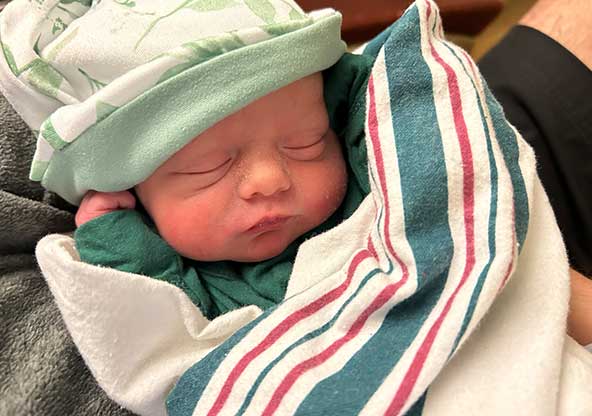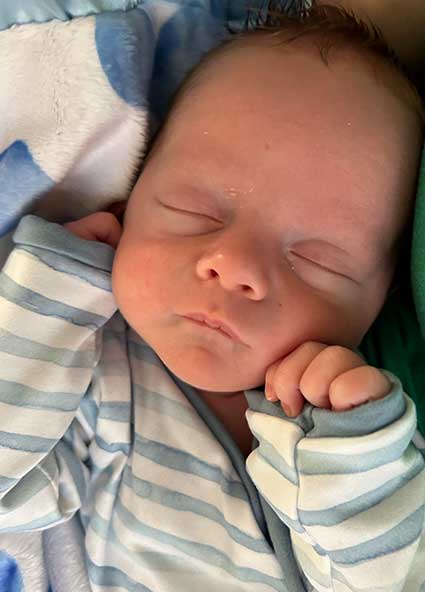Landon's Fight with MCAD
A Story of Hope, Resilience and Lifesaving Care at CHRISTUS Children's
The journey of parenthood is full of unexpected turns, and for Samantha Ansley and Ben Jones, theirs took a difficult twist. They would learn that their son had Medium Chain Acyl-CoA Dehydrogenase Deficiency, or MCAD, a rare metabolic disorder that prevents the body from properly processing fats for energy. Before knowing of his metabolic disorder, and only two days after he was born, he required immediate, expert care as he fought for his life—a journey that would lead them to CHRISTUS Children’s.
An Easy Pregnancy and a Plan for After Birth
Samantha and Ben were excited to welcome a new baby into their family. Samantha said, I felt much better during this pregnancy than my first—no morning sickness, just a little fatigue. Overall, I felt good. My blood pressure was normal, though, like last time, I did develop gestational diabetes.
Samantha and her baby, Landon, were monitored by her OB-GYN near their home in Harlingen, Texas.
As for Landon, his ultrasounds had been normal until a routine appointment revealed he had hydronephrosis, a condition where there is a buildup of urine in the kidney. While unsettling, doctors reassured Samantha and Ben that it wasn’t an immediate concern.
They recommended seeing a pediatric urologist before Landon’s birth to discuss our options and possible outcomes,
Samantha explained. While they reassured us that hydronephrosis often resolves on its own, we would need to start antibiotics after birth and schedule a 24-hour ultrasound before leaving the hospital.
Children's NICU
CHRISTUS Children's NICU
The Level IV NICU at CHRISTUS Children's in San Antonio offers advanced care for newborns and their families, especially babies born prematurely or with special medical conditions.
Landon's Birth and the First Signs of MCAD
On November 10, 2024, Landon was born at a hospital in Weslaco, Texas. He weighed 5 pounds, 13 ounces.
We were so relieved when he cried right away,
Samantha recalled. They placed him on my chest, and we were able to do skin-to-skin for a while.
Everything seemed fine. Then he began cluster feeding for nearly three straight hours, which I thought was odd, but the nurses said it was normal,
Samantha recalled.
He wasn’t feeding well, so we supplemented with formula. He seemed to throw up the formula; we think it was throw-up since it looked more digested than spit-up.
Despite these efforts, Landon’s feeding habits were still erratic. Concerned about his peculiar feeding habits, the doctors decided to keep him in the hospital for further observation.
By the end of the night, Landon had another long stretch of feeding, where he breastfed nonstop for about an hour and a half. After that, he slept for a few hours. He then didn’t want to eat, but wanted to keep sleeping.
After a short feed, we let him sleep again. It then became difficult to wake him up for another feed. The nurses suggested we take his clothes off to make him cold, so he’d wake up,
said Samantha.
More Concerns Arise
As Landon’s feeding issues persisted, Samantha and Ben grew increasingly concerned. He wasn’t crying well, his voice was hoarse and he seemed lethargic. They called a nurse in for help. When attempts to feed him failed, his color began to fade, prompting the nurse to take him to the nursery.
Soon, the doctors discovered something alarming—Landon’s blood sugar was dangerously low, just 17, far below normal. The medical team tried to start an IV to stabilize him, but his condition worsened.
Then, the worst fear of any parent became a reality.
As they stood outside the nursery, they heard a code blue siren from down the hall. Samantha and Ben knew it was for their baby. They waited anxiously for news of Landon’s condition. Two hours later, the couple learned their baby’s heart rate had dropped low enough to require CPR, including intubation.
They told us they had to bag him and get an IV in. We didn’t know at the time, but that IV saved his life, giving him the sugar he desperately needed,
Samantha said, still processing the trauma of those moments. At 2 days old, Landon was fighting for his life.
Complications and the Need for Specialized Care
After Landon was stabilized, he was transferred to a local hospital’s Level III NICU for continued intensive care. There, he initially stabilized and was extubated. The next morning, a routine X-ray revealed a collapsed right lung and an ultrasound of his heart showed abnormal pressures. He was re-intubated and positioned on his left side to aid lung recovery. Doctors ran extensive tests but found no clear explanation for everything happening.
After days of wondering, the state-mandated screening for metabolic disorders finally provided answers—he likely had Medium Chain Acyl CoA Dehydrogenase Deficiency, or MCAD, a rare condition that prevents the body from breaking down fats for energy. Left untreated, it can lead to dangerously low blood sugar and metabolic crises. The condition is primarily managed with dietary modifications. The key is to prevent the body from entering a fasting state, which could trigger a metabolic crisis due to the inability to break down stored fat for energy.
I didn’t even know what MCAD was, much less that I was a carrier,
Samantha shared, The team wanted us to transfer to a hospital with a genetic specialist, so they could provide more specific care for his needs.
The Transfer to CHRISTUS Children's
Samantha and Ben initially planned to transfer Landon to a hospital in Houston, but logistical challenges, including the lack of a suitable plane equipped with the necessary equipment for his respiratory needs, delayed the transfer. This led to the decision to airlift Landon to CHRISTUS Children's in San Antonio, which has a Level IV NICU and access to the genetic specialist Landon desperately needed— a metabolism expert who understands how the body breaks down nutrients to create energy.
The idea of him being flown in a helicopter in the middle of the night was terrifying. We didn’t know what to expect. But the nurses and the pilot were so kind and reassured us every step of the way. They were professionals, and we knew Landon would be in good hands,
Samantha recalled.
At CHRISTUS Children’s, a specialized team was ready to take over Landon’s care. The transfer was intense for the family, but upon his arrival, they felt reassured, knowing he was in the best hands.
Exceptional NICU and Specialized Care
Upon arrival at CHRISTUS Children’s, Landon was admitted to the Level IV NICU, which provides the highest level of care for critically ill newborns. Dr. Reema Paul, Dr. Maria Pierce and a team of specialists began working to stabilize Landon’s condition. His respiratory issues were carefully monitored, and the team immediately began weaning him off the jet ventilator, a high-frequency breathing machine that helps fragile lungs expand, and nitric oxide, a gas used to relax blood vessels in the lung and improve oxygen flow.
We were relieved to be at CHRISTUS Children’s, even though we were still scared,
Samantha said. The doctors and nurses were patient, thorough and kept us informed every step of the way.
The first few days at CHRISTUS Children’s were challenging. Landon’s lung function fluctuated, showing improvement one day and then a setback the next. But the team expected these ups and downs, adjusting his treatment as needed. Slowly, Landon began to improve. The ventilator and nitric oxide were gradually reduced until he was successfully extubated.
As his respiratory issues became more manageable, the focus shifted to nutrition and managing his MCAD. Since he couldn’t properly process fats, he required constant monitoring for metabolic distress.
Treatment centered around dietary modifications—avoiding prolonged fasting and ensuring frequent feeding to maintain stable blood sugar levels. He remained on a specialized IV nutrition regimen until he could feed by mouth. Landon was also evaluated by Dr. John Odom, medical director of the Metabolic Genetics Clinic at CHRISTUS Children’s.
Diagnosis of Neuroblastoma and Ongoing Care
As Landon’s breathing and metabolic conditions were being addressed, another complication arose. An ultrasound revealed his right kidney was still distended; a condition called hydronephrosis. But the scan also uncovered something more concerning: a small mass on his left adrenal gland, presumed to be neuroblastoma, or a tumor.
When they told us about the neuroblastoma, I was in shock. I just kept thinking, ‘not more.’ But the doctors were calm and reassured us that most of these tumors regress on their own. It was hard to accept, but they were optimistic,
Samantha recalled.
The oncology/hematology team at CHRISTUS Children’s explained that most neuroblastomas in infants follow more of a benign course and often resolve on their own—Landon’s case appeared to be no different. His tumor showed signs of being a more mature form, which is more likely to regress without intervention. To be sure, doctors conducted further testing, including an MRI with contrast, which confirmed no other tumors in his abdomen.
They also checked for a specific marker that neuroblastomas release, and fortunately, it was not present—a promising sign that the tumor may have developed in utero and could shrink on its own over time.
Homecoming and Monitoring for MCAD
After three weeks in the NICU, Landon was stable enough to go home on December 3, 2024, weighing 6 pounds, 8 ounces. Samantha and Ben were relieved to finally bring their baby home. Now 8 months old, Landon is thriving.
The Jones’ work closely with Dr. Odom to manage his MCAD, ensuring his metabolic needs are met, while Dr. Julie Voeller monitors his neuroblastoma (which as of his last visit was undetectable) and urologist Dr. Jeffrey Leslie tracks his hydronephrosis. To regulate his MCAD, Landon follows a strict feeding schedule every three hours and takes carnitine to help his body manage the energy process more effectively. As he grows, his feeding schedule will gradually become less frequent.
I'm so thankful for the doctors and nurses who helped us, answered all our questions and gave Landon exceptional care,
Samantha shared.
Reflecting on their experience, the Jones’ hope their story inspires others facing similar challenges.
What gave us strength was each other,
Samantha said. I kept reminding myself to stay in the present, not to get lost in the 'what ifs' It was hard, especially when everything felt overwhelming. But we held onto one thing—Landon was here, still breathing. If he had the strength to fight, then we could, too.
Learn more about CHRISTUS Children’s Neonatal Intensive Care Unit or learn more about the CHRISTUS Children's Genetics Clinic.
Genetics Clinic
CHRISTUS Children's Genetics Clinic
CHRISTUS Children's Genetics Clinic in San Antonio provides diagnosis, counseling, management, and specialized treatment for families with known or suspected genetic and metabolic conditions. With a multidisciplinary team of specialists, your family will be supported and cared for.
Cancer & Blood Disorders Clinic
CHRISTUS Children's Cancer & Blood Disorders Clinic
CHRISTUS Children's Cancer & Blood Disorders Clinic in San Antonio provides specialized pediatric cancer care backed by expert teams, proven treatments, and personalized support for your child and family from day one.



